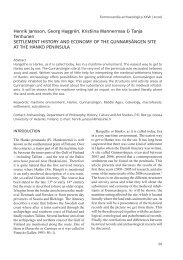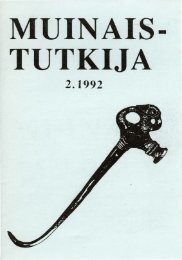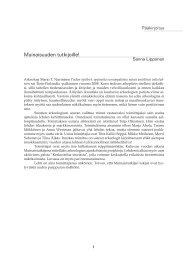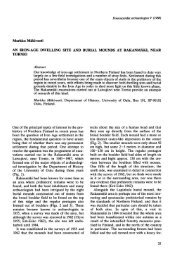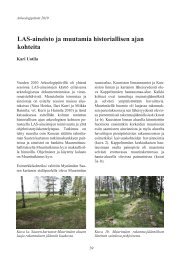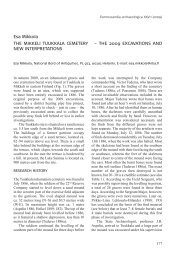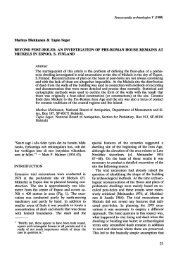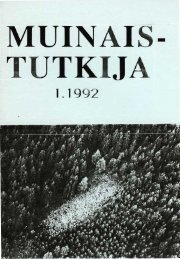Jari-Matti Kuusela MASTERS OF THE BURIAL GROUNDS â ELITES ...
Jari-Matti Kuusela MASTERS OF THE BURIAL GROUNDS â ELITES ...
Jari-Matti Kuusela MASTERS OF THE BURIAL GROUNDS â ELITES ...
You also want an ePaper? Increase the reach of your titles
YUMPU automatically turns print PDFs into web optimized ePapers that Google loves.
elite. Within this social elite are those who actually<br />
wield power granted by legitimated authority<br />
and to them, following Bottomore (1985 [1964]),<br />
I refer with the term power elite. It is important<br />
to understand that power elite is also a part of the<br />
social elite but as social elite itself is stratified,<br />
the power elite occupies the highest echelons of<br />
the social stratification within the social elite. It<br />
is evident that this dualistic approach is arbitrary<br />
but it is necessary for analytical purposes.<br />
POWER, DEFINING POWER, RESOURCES<br />
<strong>OF</strong> POWER<br />
Power exists in many forms in all social organisations<br />
and is thus an important aspect of social life<br />
and social reality. Power can be simply defined<br />
as the influence of one agent over the actions/<br />
opinions of another (Hawley 1963: 422; Olsen<br />
1970: 2). By this definition it is easy to see that<br />
power exists in all arenas of social life and is thus<br />
not a commodity which can be easily singled<br />
out or measured (Bierstedt 1950: 730; Hawley<br />
1963: 422–3; Etzioni 1968: 314–23; Olsen 1970:<br />
2–3).<br />
Power can be loosely classified, for analytical<br />
purposes, in three categories – force, dominance<br />
and authority. Of these, force is the ability to<br />
concretely apply one’s power over the others, for<br />
instance in the case of physical coercion. Dominance<br />
rests on the ability to control a resource<br />
deemed important by the others and thus, via the<br />
control of this resource, attain a position of power<br />
in the society. Authority is based on ideological<br />
and social legitimation which embeds the power<br />
in the social structures of the society. Often all<br />
three forms are present in one way or another in<br />
any given power structure (Bierstedt 1950; Olsen<br />
1970: 6–7).<br />
Though different in nature, common to all<br />
three categories of power is that they require a<br />
power resource – something the power is based<br />
on (Olsen 1970: 4). In the case of force, the power<br />
is dependent on the resources to actually apply<br />
the needed concrete coercion over others. In<br />
the case of dominance the power resource is the<br />
resource on which the dominance is based on, be<br />
this concrete physical commodity and/or an ideological<br />
resource. Authority’s power resource is a<br />
voluntarily given legitimation (Bierstedt 1950;<br />
Olsen 1970: 6–7).<br />
If the power rests on the ability of physical<br />
coercion or on a single controllable resource, the<br />
power structure is unstable and precarious (Blau<br />
1986 [1964]: 199–200; Lewellen 2003: 90). A<br />
stable power resource has two characteristics – it<br />
is embedded in the fabric of the social reality of<br />
the society and it is easily transferred from one<br />
agent to another thus removing the power structure<br />
from the individual agent (Bottomore 1985<br />
[1964]: 43; Bourdieu 1977: 183–4). Legitimated<br />
authority fulfils these two characteristics. Legitimation<br />
creates a power resource which is easily<br />
transferable and embeds the power structure into<br />
the society’s social reality. When embedded, the<br />
society itself enforces the power structure without<br />
the need of coercion. In other words, power<br />
becomes a part of the accepted social reality and<br />
agents are constrained by peer pressure to comply<br />
with it (Blau 1986 [1964]: 200; see also Bourdieu<br />
1977: 171–3).<br />
LEGITIMATION <strong>OF</strong> POWER – <strong>THE</strong> POWER<br />
<strong>OF</strong> RITUALS<br />
Because legitimated authority is the only form<br />
of a stable power structure and because legitimation<br />
can occur only if the power structure is<br />
embedded in the social reality of the society, it is<br />
a logical conclusion that legitimation must take<br />
into account the ideology of the society. Nothing<br />
is so closely related to the ideology of a society<br />
than rituals.<br />
A ritual is defined as a formal and repeating<br />
act which is often conducted in the same location<br />
(Kertzer 1988: 9). Though the term ritual can be<br />
used in many contexts (see Kertzer 1988), in this<br />
paper I use it to refer to an activity pertaining to<br />
the religious. Religion and its rituals indoctrinate<br />
followers into accepting its ideology and peoples’<br />
sense of group cohesion is at its strongest when<br />
participating in common rituals (Collins 1988:<br />
191–5, 204; Bayman 2002: 77–8). As rituals<br />
represent the ideology of the society, whoever<br />
controls them and their material representations,<br />
is in a good position to gain legitimated authority<br />
over the society (Kertzer 1988: 13–4, 29, 38;<br />
DeMarrais et al. 1996: 15–7; Earle 1997: 144;<br />
Bayman 2002: 77–8). Thus rituals are strongly<br />
intertwined with societies and especially their<br />
power structures and legitimation (Kertzer 1988;<br />
Chapman 1995: 46; Fox 1996; Lewellen 2003:<br />
65–7; Oestigaard & Goldhahn 2006: 31).<br />
40



